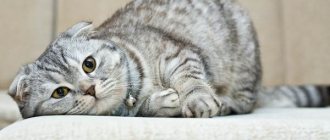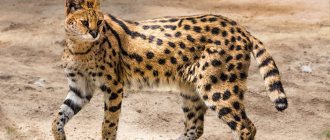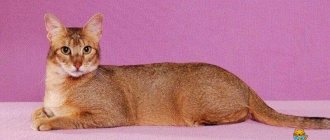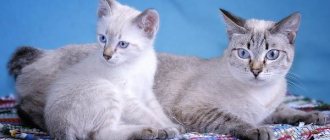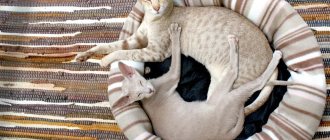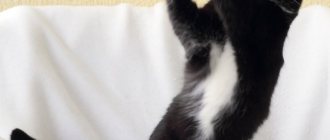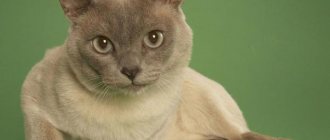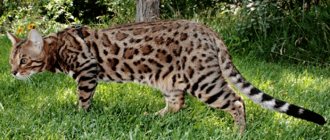In 1981, in Lakewood (California), a black kitten with unusual ears and semi-long fur found its way to the home of married couple Joe and Grace Ruga. The husband at first pretended not to notice the kitten, but his wife decided to feed the foundling. The black kitten turned out to be so cute that the couple soon fell in love with him. Since it turned out to be a cat, she was named Shulamith.
This is where the history of the American curl began. Nowadays, the pedigree of any American Curl cat can be traced back to the founder of the breed, named Shulamith.
Description of the American Curl breed
Popularity 62nd among 86 cat breeds
Lifespan:
12-20 years
Height:
Up to 30 cm
Country of origin:
USA
Average price:
10-25 thousand rubles
Weight:
3-7 kg
Latest articles Cat care
How to trim a cat's claws correctly and easily 01/28/2022 129 0 0
Dog health
How to do an ultrasound for dogs: preparation and procedure 01/28/2022 59 0 0
Interesting facts about American Curls
In fact, there are very few American Curls. The breed appeared relatively recently, so it has not yet had time to acquire numerous descendants. About two hundred kittens are born to the largest clubs and breeders of American Curls per year - this is not enough according to modern trends.
The first American Curl breeder in Russia gave an interview in which she said that the largest cat federation, which is the official founder of the American Curl breed, bred only 160 kittens in 1999, and 185 in 2000. These are catastrophic numbers that put The breed is in danger of extinction. The same breeder noted that it was very difficult to get a kitten - as a breeder she was subjected to the most serious scrutiny.
The United States is very proud of the American Curl breed. At one time, T-shirts were even common that bore the distinctive inscription: “I love my American Curl.” These T-shirts were popular among both women and men.
Due to the fact that the breed is relatively new, some habits and behavior patterns have not yet been established with reliable accuracy. Cat owners note that American Curls love people, show affection, but do not get bored and do not get underfoot. These cats are moderately energetic and love children.
The ears of adult American Curls resemble horns. Cat owners even say that cats love to butt with these horns: they crawl their heads under the arm or rub their foreheads against the legs, as if butting the owner. This is how cats ask to be petted.
Some cats like to bring offerings of dead animals to their owners. American Curls are deprived of this habit, since they have almost lost their hunting instinct. They prefer to please their owner with their presence and affection rather than with such gifts.
Key facts
Despite the congenital genetic mutation that deforms the ear cartilage, furry pets are in good health. With proper care, the maximum lifespan of American Curls is 20 years.
These animals have a hard time with loneliness. The key characteristic of the American Curl breed is its peacefulness. They easily get along with dogs and get along well with children.
According to the official description, the American Curl breed comes in shorthair and semi-longhair. Due to its spectacular appearance, the second variety, which requires more care, is more popular than the first.
These cats are often compared to the main inhabitant of Neverland: like Peter Pan, they refuse to grow up until the very end, maintaining childish restlessness and playfulness into old age.
Hereditary diseases
Thanks to its rich past, the American Curl has acquired strong immunity and iron health. She has no hereditary diseases. However, like all animals, a cat can catch a cold, have an allergic reaction, etc. To make an accurate diagnosis, be sure to visit a veterinarian who will prescribe treatment.
There are several diseases that arise as a result of improper care.
Inflammation of the ear
The problem occurs due to the curved shape and narrow ear canal. It is important to regularly examine your pet’s ears and clean them with a soft swab without damaging the cartilage.
The veterinarian cleans the ears and drips the prescribed medicine against otitis media. The hair near the ears is temporarily cut off.
Dental problems
Occurs in the absence of dry food. To keep gums and teeth healthy, your cat should regularly chew dry treats and dry food.
In case of inflammation, regular teeth cleaning with gel, anti-inflammatory drugs, changes in diet, etc. are prescribed.
History of the origin of the American Curl
The country of origin of the breed is recognized as the USA. In 1981, in California, a family named Ruga adopted a stray cat with arched ears. Just 6 years later, an unusual pet, named Shulamith, was declared the founder of a new breed.
The new owners received their first offspring soon after the appearance of their new favorite. Despite the ordinary appearance of the father, most of the kittens inherited their mother's ears. Only in 1983, the couple decided to seek advice from felinologists. The gene responsible for curling ears was recognized as dominant, which explained such frequent inheritance of an unusual appearance when mating partners of different breeds.
In 1987, the standard and name of the breed were officially established, but only for representatives with long hair. Shorthair cats had to wait another 4 years before TICA awarded them a separate standard.
In old American newspapers dating back to the 60s of the 20th century, you can find one interesting fact. It turns out that California and Oklahoma farmers encountered unusual cats even before Shulamith appeared. If, instead of reporters, they had shared their discovery with employees of international felinological organizations, then perhaps the American Curl cat would have received official status much earlier.
Diseases
The American Curl is a healthy breed, and no genetic pathologies were recorded in any individual. But improper care can provoke many diseases.
- Obesity.
- Diabetes.
- Allergy.
- Oral diseases.
- Urolithiasis (pyelonephritis, chronic renal failure).
- Worms.
- Myocarditis, myocardosis.
- Ear mites.
Be sure to give your cat all the necessary vaccinations, even if you do not let him out for walks. Calcivirosis, feline distemper, ringworm - the causative agents of all these ailments can be easily brought home by you yourself: on the soles of shoes, the edge of a jacket or on your hands. Treatment will be expensive, long and without guarantees of recovery. And rabies, which is transmitted through a bite, cannot be cured at all.
Expert opinion
Dusheba Vera Ivanovna
In 2010, she graduated from the Moscow State Academy of Veterinary Medicine named after K.I. Scriabin with honors, specializing in veterinary medicine. I regularly attend veterinary conferences, congresses, and webinars.
Curls can be mixed with cats of other breeds similar in standard. In this case, kittens are almost always born without serious deviations, but there will be noticeably fewer individuals with curls in the litter if two Curls were brought together.
Similar cat breeds
Siberian cat
Maine Coon
Norwegian Forest Cat
What does an American Curl look like?
The main feature of the breed is its arched ears, which determine the class of the animal depending on the degree of curvature. The ideal shape is a full crescent. Its owners are included in the show class and can count on maximum points from the judges.
The size of the animals is average: males weigh up to 7 kg, and females weigh up to 5 kg. The height at the withers varies from 28 to 33 cm. Boys are always larger than girls, so in the photo American Curls of different sexes are very different from each other. Despite the massive size, the overall impression focuses on the elegance and grace of these animals.
Muzzle
The breed is characterized by a wedge-shaped head with a strong and well-defined chin. Slightly slanted eyes take the shape of a walnut or an elongated oval. Large and wide ears are slightly rounded at the tips. The ear flap is bent within 90°-180°. Deviation from these indicators is considered a deficiency. The bite can be scissor-shaped or straight.
In addition to excessive or too small folding of the ears, the disadvantages include their low fit, as well as a pronounced stop at the nose. Representatives with thickened or patterned ear coverings are not allowed to the exhibition. The same fate applies to those whose ear tip reaches their head.
Body type
The head is located on a strong and slightly massive neck. The rectangular body combines well-developed muscles and elegance of the silhouette. The hind and forelimbs end in plump, rounded paws. The length of the luxurious flexible tail matches the length of the body. Its maximum thickness is observed at the base, and towards the tip it gradually decreases.
Coat and color
The standard allows for 2 varieties of American Curl: semi-longhair and shorthair. The shorter the coat, the greater its shine. Long-haired cats must have a furry tail and collar. Both species have developed guard hair and a small amount of undercoat. Having a coat that is too coarse or “cottony” is considered a fault.
The American Curl can be any color: black, red, white, gray, smoky, cream and even tortoiseshell. The only color limitation is for color point, which requires the presence of blue eyes.
Breeding
Now curls have spread throughout the planet and, thanks to permission for outcrossing, their numbers are growing quite quickly.
In the American Curl, typical regional variances exist as in other breeds. In particular, this concerns changes in the length and shape of the body and ears. To some extent, the reason for the appearance of these features is the use of non-pedigreed cats in Curl breeding programs. And, as you know, the types of domestic outbred cats for each region have significant differences. In addition, various publications allow for a not entirely correct definition of outcrossing for a given breed. There are also publications in which the American Curl is allowed to be crossed “with any purebred or purebred cat.” This approach is a direct contradiction to the only permitted option for outcrossing this breed - with domestic purebred cats.
As for the wedge-shaped head, the proportions of length and width are 3:2, the body is rectangular, then based on this, it can be understood that there is no similarity between the American Curl and the American Shorthair cat. The latter is characterized by a stocky body and a rounded head. The Curl has little in common with the eastern breeds, which have a long body and a wedge-shaped head.
Recently, some breeders have become interested in the idea of introducing the Turkish Angora into the Curl breeding program. But even with a quick glance, assessing the standard of Turkish Angoras, it becomes clear that the prospect of development of this direction is simply excluded. The fact is that the Angora standard contains a large number of positions that do not correspond to the American Curl type. In particular, this applies to the requirements for the type of body, muscles and head.
Since 2010, a ban has been introduced on many areas of outsourcing and the reproduction of curls. It has become more intra-breed, and more stringent requirements have appeared. Breeders have made every effort to improve the breed type as quickly as possible. Nurseries carried out complex programs to mix bloodlines across regional boundaries, their goal was to establish the type and preserve genetics.
Oddly enough, aboriginal cats with similarly curled ears began to be found in different parts of the world. Information about such finds came from South America, and even from Australia.
American Curl Personality
Due to the unacceptable attitude towards loneliness, “bow-eared” pets need to always have someone in the apartment. They get along well with children and other animals, and also tolerate noise and easily get to know strangers. They firmly associate the concept of home with a person, so moving to a new place is perceived not as a disaster, but as an exciting journey.
The character of the American Curl combines friendliness, activity and high intelligence. This pet is suitable for those who like to see an animal in their arms at their own request. Despite their affection, curls are not intrusive. If you have one of these cats, then she will not pester you with screams when she gets hungry or wants to express her disagreement.
Life together with a furry little eared animal will not work out only for birds and rodents. A developed hunting instinct simply will not allow them to be perceived as family members, and not as prey. Also try to be careful when leaving your pet alone with a small child. In this case, it is the animal that is in danger, since playful children’s hands can damage its fragile ears.
Character traits and lifestyle
The breed has a calm and balanced character. These are affectionate and sociable animals that feel great in company. Human company is important for a furry pet. Being alone, the cat suffers, and sometimes mental problems arise against this background.
The American Curl is different:
- Cleanliness. He doesn’t mess up the apartment and doesn’t steal food from the table. Quickly gets accustomed to the tray.
- Good manners. It stays apart and does not pester its owners.
- Fast adaptation. It tolerates moving and moving into a new home without any problems, which is associated with attachment not to a specific place, but to the owner.
- Ability to train. He follows commands, walks on a leash, is playful and is able to bring the necessary items to his owner.
- Love for companies. She is not afraid of strangers and takes an active part in noisy parties, for which she received the nickname “clown cat.”
The animal has a positive attitude and does not have sudden mood swings. The balance, cheerfulness and optimism of cats helps owners get a charge of positive emotions, and communication with them “works” better than antidepressants. But the pets themselves have a developed and vulnerable psyche: they are sensitive and have a hard time with punishment or the screams of the owner.
Raising an American Curl
Well-mannered animals do not mark their territory, do not chew their owners’ personal belongings, and do not scratch furniture, so breeders recommend not postponing training a pet indefinitely. After buying a kitten, show him the toilet and gradually begin raising him, explaining the prohibitions in your home. In this case, you won’t have to look for how to wean your pet from inappropriate actions, since he will be able to do everything he needs from childhood.
Due to their high intelligence, Curls are highly trainable and resemble dogs in many ways. A trained pet can master the prohibition command and the game command “fetch”. In the latter case, training will be equated to play, since these cats love to chase a ball or a mouse.
When training, try not to forget that you are training a feline. Unlike dogs, they do not tolerate being pushed around and do not respond well to negative reinforcements. Lower the bar of your requirements in advance and use a gaming technique. Praise your mustachioed pet even in case of failure. In this case, he will enjoy the process and will definitely try to bring you special joy with his successes.
Looking for an American Curl? Find your pet from 2 offers Buy
How is pregnancy and childbirth going?
In a healthy cat, pregnancy and birth usually proceed without problems. About 65 days after mating, kittens are born. When pregnancy occurs, it is better to switch the cat to kitten food, which contains all the necessary vitamins and nutrients for this special period. In the second half of pregnancy, you need to add another 50% of the feed to the usual portion. Closer to the beginning of labor, you should prepare a special box in which the cat will feel familiar, cozy and safe.
American Curl Health
Good living conditions and the love of the owner are the main factors influencing the life expectancy of a mustachioed pet. If all vaccinations and antiparasitic measures are followed, cats from America live up to 20 years.
Possible diseases
The health of the American Curl can only be envied. Due to the natural nature of the mutation, the breed has no genetic diseases. The only disadvantage of these cats is the ear cartilage, which is vulnerable to mechanical stress. If you do not want to treat injured ears, protect your pet from the hands of children and the enthusiastic hugs of your friends.
Reproductive health
The optimal age for castration and sterilization of an animal is 5-9 months, that is, immediately after puberty. It is recommended to operate on female cats before their first heat. In this case, the risk of developing cancer in the future is minimal.
Those who have decided to have offspring and plan to give birth on their own will have to learn a few nuances about breeding the breed. Both two purebred partners and one outbred partner can participate in mating. In the second case, the probability of giving birth to kittens with arched ears is reduced to 50%. Despite this, such matings are encouraged as they help expand the genetic diversity within the breed.
The pet's pregnancy lasts 62-68 days. The appearance of small pets is a lottery. The parent curl is not inherited. A cat can give birth to less impressive cubs or, conversely, more spectacular ones than herself.
Pros and cons of the breed
First of all, cats are loved for their gentle and easy-going nature. Curls are distinguished by excellent health and activity, as well as strong genetics. Thanks to good breeding work, many colors are acceptable. The main feature of American Curls is their curled ears.
This same feature is also the main disadvantage when choosing a representative of this breed - in the course of caring for a pet at an early age, its delicate cartilages, which are not protected by anything, can be damaged. Another obstacle for those wishing to become Curl owners is the low prevalence both in the breed’s homeland - in the USA and abroad, as well as its high cost.
Features of feeding and diet
The cost of keeping an animal always depends on its diet. For your pet's good health, never skimp on its food. Choose either natural food or at least premium food. In the second case, the guide for feeding a kitten or an adult animal, indicated on the package, will help you figure out how many times and in what portions to feed your pet.
The standards calculated by the manufacturer are based on the weight and age of the cat, so in case of illness they can be adjusted by the veterinarian. The highest price is set for holistic foods, as they contain a lot of protein. For animals with a high protein content due to problems with the genitourinary system, such feeding can be dangerous. For safety reasons, try to clarify what food to feed your pet immediately at your appointment at the veterinary clinic.
Curls are not picky eaters, so they will happily eat anything you offer them. Uncontrolled feeding is fraught with obesity and intestinal upset, so do not offer the animal more than the recommended amount. When choosing natural nutrition, use:
- lean meat (chicken, turkey, beef) and heat-treated offal;
- rice or oatmeal porridge cooked in meat broth;
- fresh cottage cheese, kefir or fermented baked milk with low fat content;
- pumpkin, beets, carrots or zucchini, stewed or boiled;
- vitamins selected by a veterinarian.
Newborn kittens are fed by their mother, so you don’t have to worry about them until they are 2 months old. Up to 6 months, babies are fed 5 times a day, and after 6 - 4. From 1 year, the animal is transferred to three meals a day, and after 1.5 years - to two meals a day, maintaining it until the end of its life.
Castration and sterilization
Sterilization and castration is the best option if you do not plan to breed animals. This will save the health of the pet and the nerves of the owners.
Castration of cats is carried out at the age of 7–9 months, when the animal has reached sexual maturity, but before the first mating. The recommended age for cat surgery is 5–7 months, before the first heat. This will reduce the risk of developing breast cancer, hormonal imbalance, diseases of the uterus and ovaries.
The older the animal, the greater the likelihood of complications after castration/sterilization. There are contraindications in which surgery is not possible:
- diseased animal heart;
- liver diseases;
- exhaustion of the body;
- infectious diseases;
- chronic kidney disease;
- unhealthy genitourinary functions;
- purulent abscesses around the genitals.
Surgeries to remove genital organs are usually performed under general anesthesia. Cats need two days to fully recover from anesthesia, males - alone. During this time and during the rehabilitation period, which can last up to 15 days, the animal requires care:
- After the operation, it is better to leave the cat in the clinic for 2-3 hours under the supervision of a doctor.
- At home, place your pet on oilcloth and cover with a blanket.
- Keep away from bright light, drafts and loud sounds.
- After anesthesia, a cat sleeps with its eyes open, to prevent the mucous membrane from drying out, periodically close its eyelids.
- The animal may have poor coordination; do not allow it to climb onto elevated surfaces.
Care and maintenance
The rules for the care and maintenance of the American Curl require careful treatment of the ears and ensuring sufficient daily activity. For the health of your furry pet, follow these recommendations:
- Brush the coat 1 or 2 times a week depending on its length. Long-haired and short-haired cats will benefit from the same set of combing tools: a comb, a massage brush and a slicker brush. During molting, the frequency of procedures is increased.
- Carry out water procedures no more than 2 times a year. More frequent washing breaks the protective fat film, so when walking frequently, rinse only the paws. To maintain the quality of the coat, use special conditioners and veterinary shampoos. After a shower, be sure to dry your pet with a towel or hairdryer.
- Keep your eyes and ears clean. Clean your eyes daily from any secretions that accumulate overnight, and clean your ears no more than once a month. Do not forget about the fragility of cartilage during processing.
- Trim the nails to prevent them from growing into the pads. If you don’t have the skill, seek a haircut at a grooming salon.
- Brush your teeth twice a month with veterinary toothpaste or regular baking soda. Regular oral care will help maintain healthy teeth into old age.
Before buying a pet, purchase a bed, bowls, a tray, a scratching post and several toys. Remember that until the first vaccination the baby will be in temporary quarantine, so do not let him into the hallway and hide his outdoor shoes in a closed closet. Try to keep an eye on the kitten for about a year. In search of adventure, he will definitely climb into the trash can or try to spin the drum of your washing machine. After vaccination, your small pet can be walked on a harness. Representatives of this breed love everything new, so try to change routes more often.
Features of behavior
The breed is social. This is not a pet that “walks on its own.” He needs communication and participates (to the extent possible) in family affairs. American Curl cat plays with children. She gets along well with other pets and even finds a “common language” with dogs.
If a Curl spends a lot of time in a confined space, then adaptations are created for it for an active lifestyle. He must satisfy the thirst for movement, realize instincts and curiosity.
Advice: The desire to play is in the blood of this breed. If you build passages, ladders, slides, and toys on your cat’s territory, this will be an ideal option and will help the animal stay active.
Tips for choosing a kitten
It is better to adopt American Curl kittens no earlier than 4 months. Babies are always born with straight ears, and deformation of the ear tissue occurs only over time. If you want to choose a future champion, then it is better to take your time and wait for the final appearance of the curl.
Choose your future pet from a nursery or from a private breeder who is a member of a felinological club. When purchasing a purebred animal, the seller must provide the following documents:
- contract of sale;
- veterinary passport;
- metrics.
The presence of straight-eared kittens in a litter is normal and should not cause your suspicion if their number does not exceed 50%. The cost of such babies will be lower.
In addition to documentation, be sure to check the appearance and activity of the future pet. The presence of an enlarged abdomen, dull fur or watery eyes indicates a disease, so it is better to refuse the purchase.
Coat color
The cat has a rich past, so any color can be found in the breed. The photo shows the most common colors.
Solid color
Pure colors are not so common, but are in great demand. White, black, blue and red colors are common. The main thing in describing a solid color is the absence of marks and changes in shade. This significantly increases the cost of the cat.
Two-color
The fur combines hairs of two colors at once. The most common are black mixed with white and red mixed with white. The color is common. These kittens are inexpensive.
Silver
Valued on a par with solid colors, it appears rarely. The photo shows a gray-blue tint that evenly covers all parts of the pet’s body. Even the tummy and muzzle are painted a single color silver. The fur must have a cool blue undertone.
Colorpoint
The photo shows the original color. The fur is light in color - gray, white, cream. On the face, paws, ears, and sometimes on the tail there are spots of darker colors, with smooth transitions into light shades. For example, Siamese cats are also representatives of this color.
Tabby
There are different variations in the description of tabby color. The marbled color with spots or slightly blurred black stripes on gray fur is considered a classic. Less common are brown stripes on the red coat or a mixture of three shades.
How much does an American Curl cost?
The price of an American curl with all documents is at least 10 thousand rubles. For this price you can buy a pet-class animal with defects that are not acceptable for breeding or participation in exhibitions. Straight-eared representatives can be purchased within 25 thousand rubles, but more elite individuals will cost 25-45 thousand rubles.
In addition to class, how much an animal costs depends on the rarity of its color and the status of the seller. Owners of chinchilla, golden and chocolate coats born in the capital's nurseries receive the highest prices.
Do you like the article? 0
Price for a kitten
As already noted, the breed is not widespread in Russia, so it is better to buy kittens in special nurseries. It is best if the future pet is four months old and the curlicue ears have acquired their characteristic features.
The price depends on the class of the animal.
For pets it starts from ten thousand rubles, and for a show-class kitten it can range up to two thousand dollars.
That is why it is extremely undesirable to purchase babies from random people, since they can easily deceive you by passing off another, less purebred cat as a Curl.
1111
